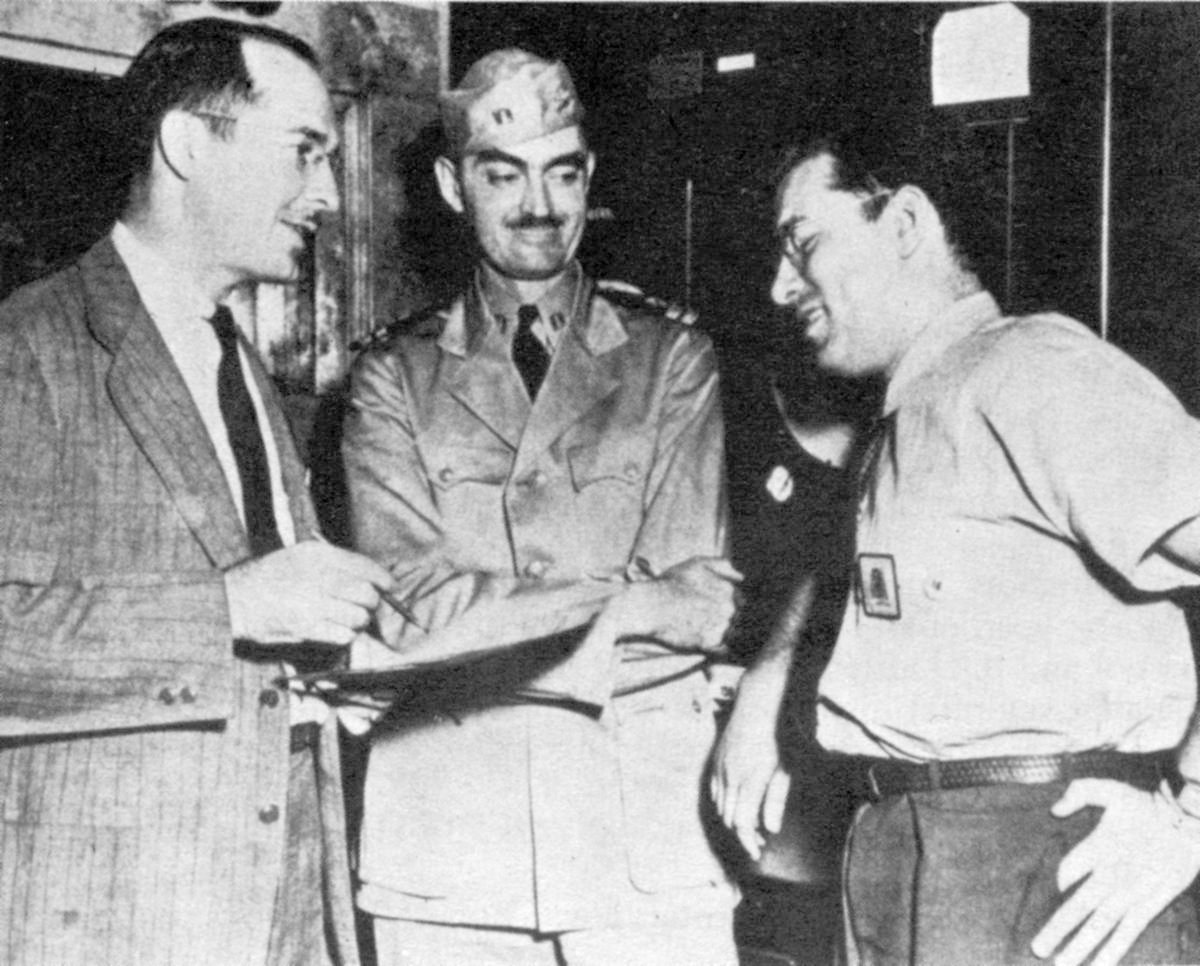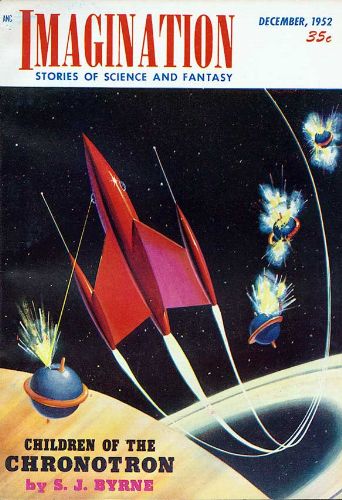|
Someday (short Story)
"Someday" is a science fiction short story by American writer Isaac Asimov. It was first published in the August 1956 issue of ''Infinity Science Fiction'' and reprinted in the collections ''Earth Is Room Enough'' (1957), ''The Complete Robot'' (1982), ''Robot Visions'' (1990), and '' The Complete Stories, Volume 1'' (1990). Plot summary The story is set in a future where computers play a central role in organizing society. Humans are employed as computer operators, but they leave most of the thinking to machines. Indeed, whilst binary programming is taught at school, reading and writing have become obsolete. The story concerns a pair of boys who dismantle and upgrade an old ''Bard'', a child's computer whose sole function is to generate random fairy tale A fairy tale (alternative names include fairytale, fairy story, household tale, magic tale, or wonder tale) is a short story that belongs to the folklore genre. Such stories typically feature magic, enchantments, and my ... [...More Info...] [...Related Items...] OR: [Wikipedia] [Google] [Baidu] |
Isaac Asimov
Isaac Asimov ( ; – April 6, 1992) was an Russian-born American writer and professor of biochemistry at Boston University. During his lifetime, Asimov was considered one of the "Big Three" science fiction writers, along with Robert A. Heinlein and Arthur C. Clarke. A prolific writer, he wrote or edited more than 500 books. He also wrote an estimated 90,000 letters and postcards. Best known for his hard science fiction, Asimov also wrote mystery fiction, mysteries and fantasy, as well as popular science and other non-fiction. Asimov's most famous work is the ''Foundation (book series), Foundation'' series, the first three books of which won the one-time Hugo Award for "Best All-Time Series" in 1966. His other major series are the ''Galactic Empire series, Galactic Empire'' series and the ''Robot series, Robot'' series. The ''Galactic Empire'' novels are set in the much earlier history of the same fictional universe as the ''Foundation'' series. Later, with ''Foundation an ... [...More Info...] [...Related Items...] OR: [Wikipedia] [Google] [Baidu] |
Earth Is Room Enough
''Earth Is Room Enough'' is a collection of fifteen short science fiction and fantasy stories and two pieces of comic verse by American writer Isaac Asimov, published in 1957. In his autobiography '' In Joy Still Felt'', Asimov wrote, "I was still thinking of the remarks of reviewers such as George O. Smith... concerning my penchant for wandering over the Galaxy. I therefore picked stories that took place on Earth and called the book ''Earth Is Room Enough''." The collection includes one story from the ''Robot'' series and four stories that feature or mention the fictional computer Multivac. In 2024, it was republished by HarperVoyager as the first half of "Living Space and Other Stories". It also formed the first half of "The Complete Stories, Volume 1" published in 2001. Contents *" The Dead Past" (1956), novelette, a ''Multivac'' story *"The Foundation of S.F. Success" (1954), poem *" Franchise" (1955), a ''Multivac'' story *" Gimmicks Three" (1956) *" Kid Stuff" (195 ... [...More Info...] [...Related Items...] OR: [Wikipedia] [Google] [Baidu] |
Multivac Short Stories By Isaac Asimov
Multivac is a fictional supercomputer appearing in over a dozen science fiction stories by American writer Isaac Asimov. Asimov's depiction of Multivac, a mainframe computer accessible by terminal, originally by specialists using machine code and later by any user, and used for directing the global economy and humanity's development, has been seen as the defining conceptualization of the genre of computers for the period (1950s–1960s). Multivac has been described as the direct ancestor of HAL 9000. Description Like most of the technologies Asimov describes in his fiction, Multivac's exact specifications vary among appearances. In all cases, it is a government-run computer that answers questions posed using natural language, and it is usually buried deep underground for security purposes. According to his autobiography '' In Memory Yet Green'', Asimov coined the name in imitation of UNIVAC, an early mainframe computer. Asimov had assumed the name "Univac" denoted a computer with ... [...More Info...] [...Related Items...] OR: [Wikipedia] [Google] [Baidu] |
Fairy Tale
A fairy tale (alternative names include fairytale, fairy story, household tale, magic tale, or wonder tale) is a short story that belongs to the folklore genre. Such stories typically feature magic, enchantments, and mythical or fanciful beings. In most cultures, there is no clear line separating myth from folk or fairy tale; all these together form the literature of preliterate societies. Fairy tales may be distinguished from other folk narratives such as legends (which generally involve belief in the veracity of the events described) and explicit moral tales, including beast fables. Prevalent elements include dragons, dwarfs, elves, fairies, giants, gnomes, goblins, griffins, merfolk, monsters, monarchy, pixies, talking animals, trolls, unicorns, witches, wizards, magic, and enchantments. In less technical contexts, the term is also used to describe something blessed with unusual happiness, as in "fairy-tale ending" (a happy ending) or "fairy-tale romance". ... [...More Info...] [...Related Items...] OR: [Wikipedia] [Google] [Baidu] |
Binary Data
Binary data is data whose unit can take on only two possible states. These are often labelled as 0 and 1 in accordance with the binary numeral system and Boolean algebra. Binary data occurs in many different technical and scientific fields, where it can be called by different names including '' bit'' (binary digit) in computer science, '' truth value'' in mathematical logic and related domains and '' binary variable'' in statistics. Mathematical and combinatoric foundations A discrete variable that can take only one state contains zero information, and is the next natural number after 1. That is why the bit, a variable with only two possible values, is a standard primary unit of information. A collection of bits may have states: see binary number for details. Number of states of a collection of discrete variables depends exponentially on the number of variables, and only as a power law on number of states of each variable. Ten bits have more () states than three dec ... [...More Info...] [...Related Items...] OR: [Wikipedia] [Google] [Baidu] |
Computers
A computer is a machine that can be programmed to automatically carry out sequences of arithmetic or logical operations ('' computation''). Modern digital electronic computers can perform generic sets of operations known as ''programs'', which enable computers to perform a wide range of tasks. The term computer system may refer to a nominally complete computer that includes the hardware, operating system, software, and peripheral equipment needed and used for full operation; or to a group of computers that are linked and function together, such as a computer network or computer cluster. A broad range of industrial and consumer products use computers as control systems, including simple special-purpose devices like microwave ovens and remote controls, and factory devices like industrial robots. Computers are at the core of general-purpose devices such as personal computers and mobile devices such as smartphones. Computers power the Internet, which links billions o ... [...More Info...] [...Related Items...] OR: [Wikipedia] [Google] [Baidu] |
The Complete Stories (Asimov)
''The Complete Stories'' is a discontinued series intended to form a definitive collection of Isaac Asimov's short stories and novels. Originally published in 1990 (Volume 1) and 1992 (Volume 2) by Doubleday (publisher), Doubleday, it was discontinued after the second book of the planned series. Altogether 88 of Asimov's Isaac Asimov short stories bibliography, 383 published short stories are collected in these two volumes. Volume 1 The first volume consists of the stories previously collected in ''Earth Is Room Enough'', ''Nine Tomorrows'', and ''Nightfall and Other Stories'' (but not the commentary from ''Nightfall and Other Stories''). In 2001, Broadway Books published a new edition of the first volume (hardback: , paperback: ). In 2024, it was republished by HarperVoyager as "Living Space and Other Stories". Volume One contains the following short stories: # The Dead Past # The Foundation of S. F. Success # Franchise (short story), Franchise # Gimmicks Three # Kid Stuff # Th ... [...More Info...] [...Related Items...] OR: [Wikipedia] [Google] [Baidu] |
Robot Visions
''Robot Visions'' (1990) is a collection of science fiction short stories and factual essays by Isaac Asimov. Many of the stories are reprinted from other Asimov collections, particularly '' I, Robot'' and '' The Bicentennial Man and Other Stories''. It also includes the title story, "Robot Visions" (written specifically for this collectionAsimov, Isaac: ''Robot Visions'', p. 17. Roc, 1990.), which combines Asimov's motifs of robots and of time travel. It is the companion book to '' Robot Dreams'' (1986). Contents Introduction: The Robot Chronicles An 18-page introductory essay by Asimov, consisting of 17 pages of text and a one-page illustration by Ralph McQuarrie (these are the page counts of the hardcover edition). This essay (minus the illustration) was later reprinted in Asimov's collection ''Gold Gold is a chemical element; it has chemical symbol Au (from Latin ) and atomic number 79. In its pure form, it is a brightness, bright, slightly orange-yellow, dense, ... [...More Info...] [...Related Items...] OR: [Wikipedia] [Google] [Baidu] |
The Complete Robot
''The Complete Robot'' (1982) is a collection of 31 of the 37 science fiction short stories about robots by American writer Isaac Asimov, written between 1939 and 1977.Introduction, ''The Complete Robot'', Isaac Asimov Most of the stories had been previously collected in the books '' I, Robot'' and '' The Rest of the Robots'', while four had previously been uncollected and the rest had been scattered across five other anthologies. They share a theme of the interaction of humans, robots and morality, and put together tell a larger story of Asimov's fictional history of robotics. The stories are grouped into categories. Contents * Introduction * Some Non-human Robots ** " A Boy's Best Friend" (1975) ** " Sally" (1953) ** " Someday" (1956), also ''Multivac'' series * Some Immobile Robots ** " Point of View" (1975), also ''Multivac'' series ** " Think!" (1977) ** " True Love" (1977), also ''Multivac'' series * Some Metallic Robots ** " Robot AL-76 Goes Astray" (1942) ** " Victory Un ... [...More Info...] [...Related Items...] OR: [Wikipedia] [Google] [Baidu] |
Short Story
A short story is a piece of prose fiction. It can typically be read in a single sitting and focuses on a self-contained incident or series of linked incidents, with the intent of evoking a single effect or mood. The short story is one of the oldest types of literature and has existed in the form of legends, Myth, mythic tales, Folklore genre, folk tales, fairy tales, tall tales, fables, and anecdotes in various ancient communities around the world. The modern short story developed in the early 19th century. Definition The short story is a crafted form in its own right. Short stories make use of plot, resonance and other dynamic components as in a novel, but typically to a lesser degree. While the short story is largely distinct from the novel or novella, novella/short novel, authors generally draw from a common pool of literary techniques. The short story is sometimes referred to as a genre. Determining what exactly defines a short story remains problematic. A classic definition ... [...More Info...] [...Related Items...] OR: [Wikipedia] [Google] [Baidu] |
Multivac
Multivac is a fictional supercomputer appearing in over a dozen science fiction stories by American writer Isaac Asimov. Asimov's depiction of Multivac, a mainframe computer accessible by terminal, originally by specialists using machine code and later by any user, and used for directing the global economy and humanity's development, has been seen as the defining conceptualization of the genre of computers for the period (1950s–1960s). Multivac has been described as the direct ancestor of HAL 9000. Description Like most of the technologies Asimov describes in his fiction, Multivac's exact specifications vary among appearances. In all cases, it is a government-run computer that answers questions posed using natural language, and it is usually buried deep underground for security purposes. According to his autobiography '' In Memory Yet Green'', Asimov coined the name in imitation of UNIVAC, an early mainframe computer. Asimov had assumed the name "Univac" denoted a computer wit ... [...More Info...] [...Related Items...] OR: [Wikipedia] [Google] [Baidu] |
Science Fiction
Science fiction (often shortened to sci-fi or abbreviated SF) is a genre of speculative fiction that deals with imaginative and futuristic concepts. These concepts may include information technology and robotics, biological manipulations, space exploration, time travel, Parallel universes in fiction, parallel universes, and extraterrestrials in fiction, extraterrestrial life. The genre often explores human responses to the consequences of projected or imagined scientific advances. Science fiction is related to fantasy (together abbreviated wikt:SF&F, SF&F), Horror fiction, horror, and superhero fiction, and it contains many #Subgenres, subgenres. The genre's precise Definitions of science fiction, definition has long been disputed among authors, critics, scholars, and readers. Major subgenres include hard science fiction, ''hard'' science fiction, which emphasizes scientific accuracy, and soft science fiction, ''soft'' science fiction, which focuses on social sciences. Other no ... [...More Info...] [...Related Items...] OR: [Wikipedia] [Google] [Baidu] |




